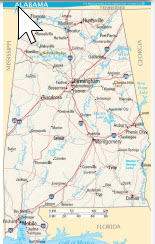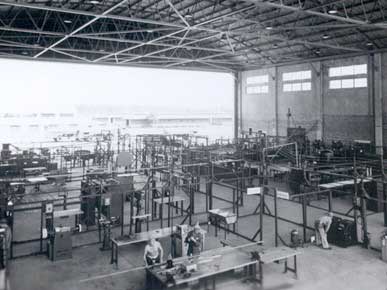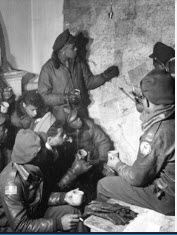Learn
Sweet Home
Alabama's Role in World War II
The state of Alabama had significant contributions throughout the war. Alabama manufacturing plants produced needed aluminum, textiles, and forestry products. The port of Mobile became a hub for the transportation of military goods. African-American pilots were trained in Tuskegee, Alabama. In addition, Aliceville, Alabama became home to a POW camp that housed as many as 6,000 German prisoners of war. Read World War II and Alabama from the Alabama Encyclopedia to learn more about Alabama's role in World War II.

Alabama flag

Alabama state seal
Military Bases
Federal dollars poured into Alabama through various army training bases and air fields. Air bases included Maxwell and Gunter Air Bases in Montgomery, Craig Field in Selma, Brookley Field in Mobile, and Fort Rucker in Ozark/Enterprise. Army bases included Fort McClellan and Anniston Ordnance Works in Anniston and Redstone Arsenal in Huntsville.

Map from the National Atlas of the United States | Public Domain
Manufacturing in Alabama
Steel mills in the Birmingham area, particularly United States Steel, received millions of dollars in contracts for defense-related products such as bombs, helmets, and steel for ship-building. Alabama also played a critical role in the production of aluminum, which is the ideal material for military aircraft because it is both strong and light. Alcoa Aluminum had a plant in Mobile and Reynolds Metals had a facility in the Tennessee Valley. In addition, Alabama's textile mills spun and wove furiously to produce fabric for uniforms, while its timber industry boomed as a result of wartime demand for construction and paper products.

Courtesy of Birmingham Public Library Archives.
The Port of Mobile
Alabama played a crucial role in the war at sea. Mobile was the home port for two important shipyards that won contracts to build desperately needed merchant vessels and warships. Alabama Drydocks and Shipbuilding (ADDSCO) built freighters and tankers. Gulf Shipbuilding, a subsidiary of Waterman Shipping, constructed destroyers and minesweepers. Waterman Steamship Company freighters transported valuable wartime cargo throughout the world. More than any other Alabama city, Mobile boomed as a result of wartime production. At the height of the war, the two shipyards and Brookley Field employed nearly 60,000 people.

Brookley Field in Mobile was the site of the Southeast Army Air Depot and the Mobile Air Service Command during World War II. The field was turned over to the city of Mobile in the 1960s and is now Mobile Downtown Airport. Courtesy of Air Force Historical Research Agency.
P.O.W. Camp in Aliceville
Soldiers from Rommel's Afrika Corps, captured in Tunisia, were transported across the Atlantic to various P.O.W. (prisoner of war) camps in the States. One such camp was in Aliceville, Alabama. It must have been a strange sight for Aliceville residents to see uniformed Nazis being marched down the streets. At its height, the camp housed nearly 6,000 German prisoners. In a strange twist, many of the German prisoners in the postwar years decided to return to live in America. Read Aliceville Museum's German POW to learn more about the POW camp in Aliceville.

German prisoners form in lines to march to Camp Aliceville in Pickens County, ca. 1943. Enemy soldiers in Alabama prisoner of war camps experienced generally comfortable and humane conditions, in line with the 1929 Geneva Conventions. Courtesy of Alabama Department of Archives and History.
Tuskegee Airmen
Despite segregation in the military, African Americans were determined that the war in Europe could change the landscape at home. The Army air force created the 99th Pursuit Squadron, also known as the Tuskegee Airmen, which was an African American pilot unit trained in Tuskegee, Alabama. The squadron played a vital role during the Battle of Anzio during the Italian campaign.
The men of the 99th Squadron were just some of the 996 African-American pilots who graduated from the Tuskegee Army Airfield from 1941-1946. Read Tuskegee Airmen from History.com to learn more.

The Tuskegee Airmen were a highly respected U.S. Army Air Corps fighting squadron during World War II and contributed to racial integration in the U.S. military. The squadron's training site was located at Tuskegee Institute in central Macon County. Courtesy of Library of Congress.